The Epiglottitis Treatment Market is estimated to be valued at USD 11.5 billion in 2025 and is projected to reach USD 18.4 billion by 2035, registering a compound annual growth rate (CAGR) of 4.8% over the forecast period.
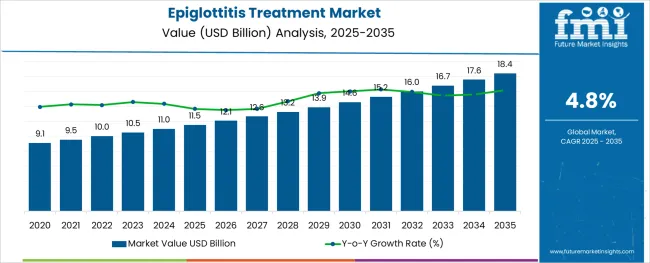
The epiglottitis treatment market is expanding steadily due to the increasing prevalence of respiratory infections and improved diagnostic capabilities. Rising awareness about early intervention and treatment options has led to enhanced demand for effective therapies. Healthcare providers have been focusing on timely administration of drugs to prevent complications such as airway obstruction.
Advances in pharmaceutical formulations and treatment protocols have improved patient outcomes and reduced hospital stays. The growing availability of treatment in both inpatient and outpatient settings has also contributed to market growth.
Future expansion is expected to be driven by innovations in drug delivery and increased access to healthcare facilities. Segmental growth is anticipated to be led by broad-spectrum antibiotics in drug types, parental route of administration, and hospitals pharmacies as the primary end users due to their critical role in acute care management.
The market is segmented by Drug, Route of Administration, and End User and region. By Drug, the market is divided into Broad-spectrum Antibiotic, Targeted Antibiotic, and Steroid Medication. In terms of Route of Administration, the market is classified into Parental and Oral. Based on End User, the market is segmented into Hospitals Pharmacies, Retail Pharmacies, Drug Stores, Clinics, and Online Pharmacies. Regionally, the market is classified into North America, Latin America, Western Europe, Eastern Europe, Balkan & Baltic Countries, Russia & Belarus, Central Asia, East Asia, South Asia & Pacific, and the Middle East & Africa.
The market is segmented by Drug, Route of Administration, and End User and region. By Drug, the market is divided into Broad-spectrum Antibiotic, Targeted Antibiotic, and Steroid Medication. In terms of Route of Administration, the market is classified into Parental and Oral. Based on End User, the market is segmented into Hospitals Pharmacies, Retail Pharmacies, Drug Stores, Clinics, and Online Pharmacies. Regionally, the market is classified into North America, Latin America, Western Europe, Eastern Europe, Balkan & Baltic Countries, Russia & Belarus, Central Asia, East Asia, South Asia & Pacific, and the Middle East & Africa.
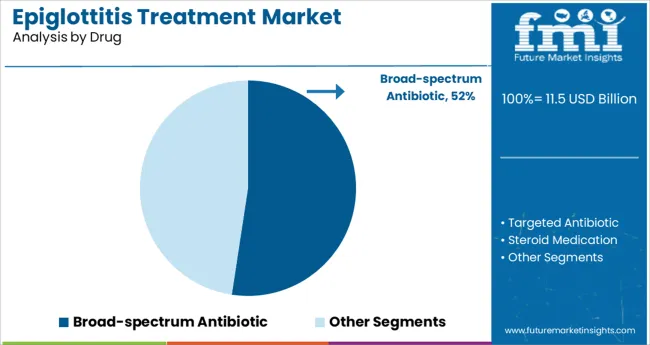
The broad-spectrum antibiotic segment is projected to hold 52.4% of the epiglottitis treatment market revenue in 2025, maintaining its position as the dominant drug type. This segment has grown because of the effectiveness of broad-spectrum antibiotics in targeting a wide range of bacterial pathogens commonly responsible for epiglottitis. Clinicians prefer broad-spectrum antibiotics to quickly manage infections while awaiting specific pathogen identification.
The versatility and proven efficacy of these antibiotics in treating severe infections have made them a first-line therapy. Additionally, improvements in antibiotic formulations have enhanced their pharmacokinetic profiles, improving patient compliance and outcomes.
As resistance management and early treatment remain priorities, broad-spectrum antibiotics will continue to lead the drug segment.
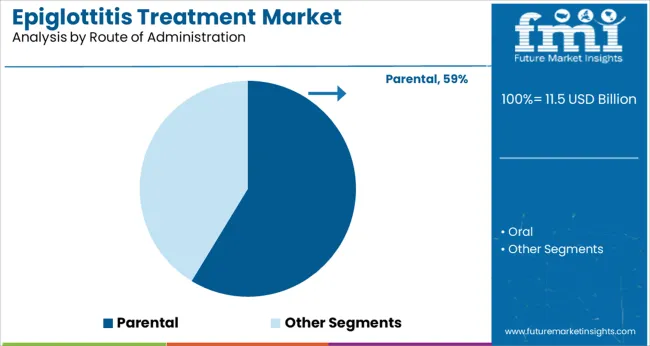
The parental route of administration is expected to account for 58.7% of the market revenue in 2025, reflecting its preference for rapid and effective drug delivery in acute epiglottitis cases. Parental administration enables immediate therapeutic action, which is crucial in preventing airway obstruction and severe complications.
Hospitals have standardized parental delivery in emergency and intensive care settings to ensure optimal drug bioavailability. The segment’s dominance is also supported by the need for close patient monitoring during treatment and the inability of some patients to tolerate oral medications due to swallowing difficulties.
With acute management continuing to require fast and reliable drug delivery, the parental route will remain the leading administration method.
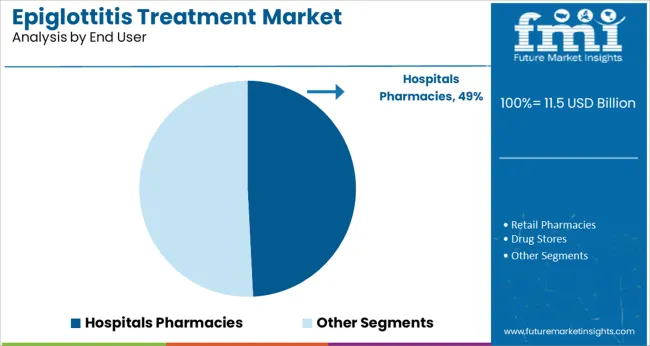
Hospitals pharmacies are projected to contribute 49.2% of the epiglottitis treatment market revenue in 2025, reflecting their central role in providing timely access to treatment. These institutions have well-established supply chains and clinical protocols to manage epiglottitis efficiently.
The presence of specialized healthcare professionals and emergency care units in hospitals ensures prompt diagnosis and treatment initiation. Hospitals pharmacies also play a critical role in managing inventory of broad-spectrum antibiotics and parental formulations, ensuring availability for acute care.
Furthermore, the growing number of hospital admissions for respiratory infections supports steady demand within this segment. As healthcare infrastructure strengthens globally, hospitals pharmacies are expected to remain the primary end users for epiglottitis treatment.
During the forecast period, the increasing prevalence and incidence rate of epiglottitis are expected to contribute to the growth of the Epiglottitis Treatment market. HIB vaccination and third generation cephalosporin, which is administered via the parental route (intramuscular/intravenous) and is effective against Haemophilus influenzae type B, which causes Epiglottitis disease, is expected to drive the Epiglottitis Treatment market.
Because epiglottitis is an inflammatory disease caused by a variety of organisms, antibiotics and the combination of an intravenous ant staphylococcal agent are expected to grow significantly during the Epiglottitis Treatment market forecast period. Furthermore, the soaring unhealthy lifestyle combined with lack of cleanliness is anticipated to boost the market’s growth.
Even though epiglottitis treatment is flourishing, there are still some factors impeding the growth of the worldwide epiglottitis treatment market. Epiglottitis Treatment drugs can occasionally cause depression and other side effects, limiting the Epiglottitis Treatment market's growth.
The primary restraint of the Epiglottitis Treatment market is a lack of access to healthcare facilities, affordability constraints, and a lack of market penetration of approved drugs.
The Epiglottitis Treatment market in Asia Pacific is projected to thrive at a substantial CAGR of 4.5% over the assessment period from 2025 to 2035. The inclusion of one of the largest economies, such as India and China, is projected to boost the market of the APAC epiglottitis treatment market. As a result of the availability of funds for research and development, this region is expected to observe significant growth in the epiglottitis treatment market.
On the other hand, APAC is further experiencing prominent growth prospects in the epiglottitis treatment market due to increased bacterial infection prevalence as well as increased investment in healthcare infrastructure.
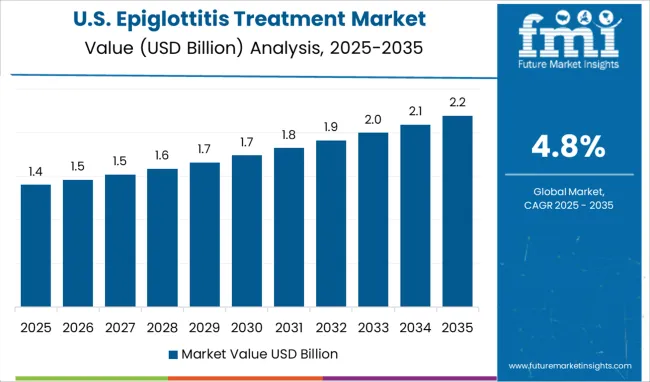
According to Future Market Insights, North America is predicted to dominate the worldwide Epiglottitis Treatment market with a significant CAGR of 4.9%, due to higher adoption and number of customers using Epiglottitis Treatment, as well as increased awareness about Epiglottitis disease. Around 7 million Americans have weak immune system which is also one of the causes of epiglottitis.
In addition to that, an estimated 11.5 million people over the age of 12 use cocaine each month In the United States which is another cause of epiglottitis. Moreover, due to the recent technological advancements and the presence of a variety of novel drug molecules to improve the treatment procedure in the region, the North America epiglottitis treatment market is anticipated to flourish during the forecast period from 2025 to 2035.
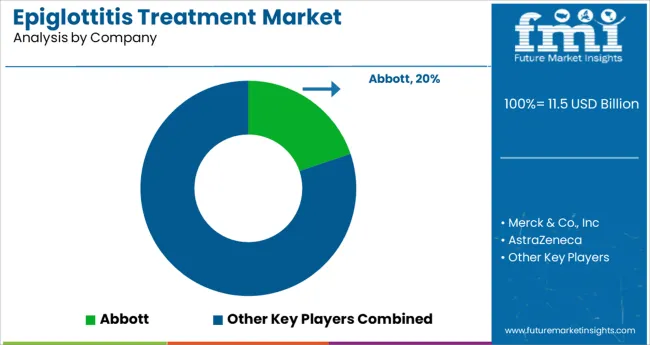
The global epiglottitis treatment market is a moderately fragmented market. Abbott, Merck & Co., Inc., AstraZeneca, Boehringer Ingelheim International GmbH, Pfizer Inc., Sanofi, Teva Pharmaceutical Industries Ltd., GlaxoSmithKline Plc., Johnson & Johnson, Roche Holding AG, and others are some of the market participants identified in the global Epiglottitis Treatment market.
| Report Attribute | Details |
|---|---|
| Growth Rate | CAGR of 5% from 2025 to 2035 |
| Market Value in 2025 | USD 10 Billion |
| Market Value in 2035 | USD 16 Billion |
| Base Year for Estimation | 2024 |
| Historical Data | 2020 to 2024 |
| Forecast Period | 2025 to 2035 |
| Quantitative Units | Revenue in million and CAGR from 2025 to 2035 |
| Report Coverage | Revenue Forecast, Volume Forecast, Company Ranking, Competitive Landscape, Growth Factors, Trends and Pricing Analysis |
| Segments Covered | Drug Type, Route of Administration, End User, Region |
| Regions Covered | North America; Latin America; Europe; Asia Pacific; Middle East and Africa |
| Key Countries Profiled | USA, Canada, Brazil, Mexico, Germany, UK, France, Spain, Italy, Russia, BENELUX, China, Japan, South Korea, GCC, South Africa, Turkey |
| Key Companies Profiled | Abbot; Merck & Co., Inc.; AstraZeneca; Boehringer Ingelheim International GmbH; Pfizer Inc.; Sanofi; Teva Pharmaceutical Industries Ltd.; GlaxoSmithKline Plc.; Johnson & Johnson; Roche Holding AG |
| Customization | Available Upon Request |
The global epiglottitis treatment market is estimated to be valued at USD 11.5 billion in 2025.
It is projected to reach USD 18.4 billion by 2035.
The market is expected to grow at a 4.8% CAGR between 2025 and 2035.
The key product types are broad-spectrum antibiotic, targeted antibiotic and steroid medication.
parental segment is expected to dominate with a 58.7% industry share in 2025.






Full Research Suite comprises of:
Market outlook & trends analysis
Interviews & case studies
Strategic recommendations
Vendor profiles & capabilities analysis
5-year forecasts
8 regions and 60+ country-level data splits
Market segment data splits
12 months of continuous data updates
DELIVERED AS:
PDF EXCEL ONLINE
Treatment-Resistant Hypertension Management Market Size and Share Forecast Outlook 2025 to 2035
Treatment-Resistant Depression Treatment Market Size and Share Forecast Outlook 2025 to 2035
Treatment Pumps Market Insights Growth & Demand Forecast 2025 to 2035
Pretreatment Coatings Market Size and Share Forecast Outlook 2025 to 2035
Air Treatment Ozone Generator Market Size and Share Forecast Outlook 2025 to 2035
CNS Treatment and Therapy Market Insights - Trends & Growth Forecast 2025 to 2035
Seed Treatment Materials Market Size and Share Forecast Outlook 2025 to 2035
Acne Treatment Solutions Market Size and Share Forecast Outlook 2025 to 2035
Scar Treatment Market Overview - Growth & Demand Forecast 2025 to 2035
Soil Treatment Chemicals Market
Algae Treatment Chemical Market Forecast and Outlook 2025 to 2035
Water Treatment Market Size and Share Forecast Outlook 2025 to 2035
Water Treatment Ozone Generator Market Size and Share Forecast Outlook 2025 to 2035
Water Treatment Equipment Market Size and Share Forecast Outlook 2025 to 2035
Burns Treatment Market Overview – Growth, Demand & Forecast 2025 to 2035
CRBSI Treatment Market Insights - Growth, Trends & Forecast 2025 to 2035
Water Treatment Polymers Market Growth & Demand 2025 to 2035
Water Treatment System Market Growth - Trends & Forecast 2025 to 2035
Water Treatment Chemical Market Growth – Trends & Forecast 2024-2034
Asthma Treatment Market Forecast and Outlook 2025 to 2035

Thank you!
You will receive an email from our Business Development Manager. Please be sure to check your SPAM/JUNK folder too.
Chat With
MaRIA